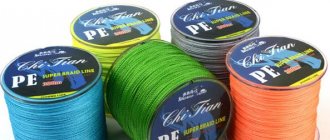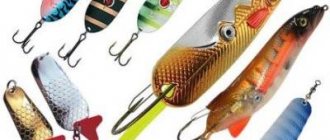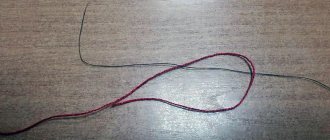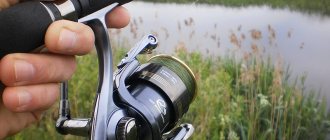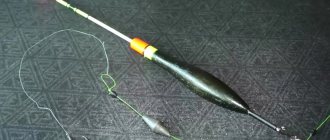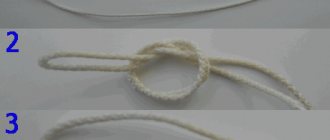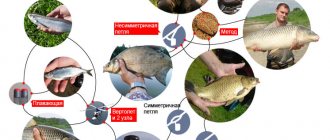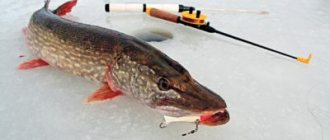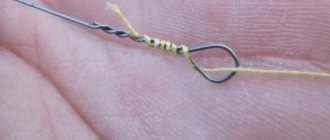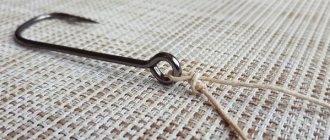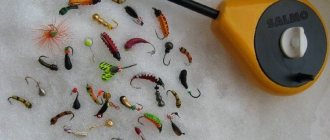Braided fishing line - types
Fishing lines made from polyethylene fibers are made in a variety of ways. We can only distinguish two main techniques:
- Classic weaving: fibers are woven into small threads, these threads into larger threads, etc. Depending on the number of threads, one or another thickness of the cord and its strength are obtained. The thinner the bundles and the better they are intertwined, the stronger the fishing line. Braided fishing lines made from simply twisted bundles of threads are significantly inferior in strength and quality to real braided fishing lines.
- Connection by heat treatment: parallel multi-filament lines in which the fibers are not intertwined, but are joined by an alloy of special binder materials. The fibers in the fishing line are located parallel to each other, remaining in the bundle due to fusion using a special additive and heating. This type of braided fishing line has quite a few varieties of alloys and many manufacturing companies come up with their own original methods.
What is braided fishing line made of?
The first braids were known as weaving threads with horsehair, which added strength to the structure, but had many disadvantages, such as moisture absorption.
Until recently in the 20th century, the fibers from which braided cords are formed were made from nylon. Subsequently, this material was replaced with a more modern one - polyethylene (plastic). Dyneema, spectra, PE fibers and, accordingly, most polyethylene braids are made from it.
The above fiber manufacturers are monopolists, and high-quality, original fibers are manufactured in only three places in the world:
- Holland (Dutch State Mines factory) – brand of dyneema or dyneema braid;
- USA (allied signa factory) – spectra or spectrum brand;
- Japan (toyobo factory), but under license from the Dutch.
A short video in which you will get acquainted with the process of making braids
The difference between the braids of these manufacturers is that each of them uses its own manufacturing technology, and the preference of one or another company is a personal matter for each fisherman.
For example, a braid made by weaving polyethylene threads into bundles is tens of times stronger than a similar bundle made of steel. Therefore, the Dutch act as the best manufacturers of such miracle fibers, which have found their application in the military industry.
You need to know that Dutch dyneema is the same as PE, but this does not mean that all braids made in any corner of the world are related to them. The Chinese successfully copy braided fishing lines, but not from polyethylene, such as nylon and other less durable materials.
2.1 Weaving
Methods of weaving threads:
- Classic . With this method of weaving, the fibers are combined into a thread, which is intertwined with the same threads and as a result form one larger thread. The resulting cord is distinguished by its strength and diameter due to the number of fibers woven into a common thread and connected to a certain number of such threads. The most popular weaves are 3, 6 and 8 threads.
- Parallel weaving . In such wicker products, weaving is not used, but the fibers are connected in parallel to each other with a special adhesive solution. In this method, the strength and durability of the resulting product depends on the chemical composition used, which is patented and kept in the strictest confidence by each manufacturer. An example of such weaving is fireline brand fishing line - it is rigid, easily untangles and is not afraid of winding to the edges of the spool.
Weaving affects the stretchability of the thread. Some manufacturers may indicate on their product a complete lack of stretchability, but this should not be taken at face value, since all fishing lines are subject to stretching, just some types are less stretchable.
All fibrous fishing lines are stronger and thinner due to the dense weave, but there is no big difference between the weaving method; there is a difference in price, which increases for threads with parallel weaving.
European braids are divided according to the quality of the weave as follows:
- “oval” - the cord consists of 4 threads 5 cm long, woven with a diameter of 1 cm, which means it is a loose thread;
- “round” – 4 10 cm threads woven into a 1 cm cord – average quality braided line.
- “round super braid” – made of 8 threads – good dense thread quality.
The indicated methods of weaving threads will help a novice spinning fisherman understand the advantages and features of braided fishing line in order to make his choice more confidently.
2.2 Surface of the braid and its impregnation
Each manufacturer has its own impregnation. What is it for? First of all, to improve the quality of the fishing line. The chemical composition has a positive effect on heat and cold resistance, resistance to salt water, silent flight when casting, etc.
The shell is needed to smooth out all the unevenness resulting from the weaving, to protect the product from various natural factors, such as stones, algae, dirt, etc. This coating affects the casting distance.

Important! The quality of impregnation plays an important role, and if when purchasing you notice peeling or crumbs, then it is better not to buy such braid.
Braided line material and color
Currently, fishing lines are mainly made from various synthetic materials (polyamide, fluorocarbon), and nylon ones are also found. Most often, braided fishing lines are made from polyethylene thread.
For fish that live at great depths, braided fishing line (excluding bright fluorescent line) will not be noticeable. In summer, conditions are more varied, and it is difficult to give clear recommendations on the choice of fishing line color. The fishing line is selected based on the color of the water in the reservoir, the presence of vegetation, the color of the bottom and other factors. In muddy water, line color is usually not critical to camouflage, but there are exceptions. In any case, you need to choose the color of the fishing line, first of all, based on the object of fishing.
Dark fishing lines in muddy or cloudy water are hardly noticeable for ide, silver bream, white bream, perch and some other fish. And for fishing for carp and carp, a dark, even black color of fishing line is preferable.
Visual acuity in predatory fish is an order of magnitude lower, and the color of the fishing line does not matter so much.
There is also a multi-color fishing line, equal sections of which in the reel are colored in different colors. It is used mainly in spinning fishing - with its help it is easier for the fisherman to determine to which place at what depth the cast was made.
Breaking load of braided line
This characteristic is the most important and is always indicated on the packaging. The breaking strength and the diameter of the fishing line are closely related to each other, however, the breaking strength for fishing lines of the same diameter, but of different types, can differ significantly. What is considered more important when choosing a fishing line depends only on its application. The breaking strength of imported lines is usually measured in pounds. One pound (denoted as "lb" from the Latin "libra") is equal to 453.6 grams. Below is a list of typical line test values, expressed in pounds (lb) / kilograms (kg) up to 100lb test, although lines are available in up to 500lb test:
| Test lb/kg | Test lb/kg | Test lb/kg | Test lb/kg | Test lb/kg |
| 2lb / 0.907kg | 7lb / 3.18kg | 16lb / 7.26kg | 25lb / 11.34kg | 55lb / 24.95kg |
| 3lb / 1.36kg | 8lb / 3.63kg | 17lb / 7.71kg | 26lb / 11.79kg | 60lb / 27.22kg |
| 3.5lb / 1.59kg | 10lb / 4.54kg | 18lb / 8.16kg | 30lb / 13.61kg | 65lb / 29.48kg |
| 4lb / 1.81kg | 11lb / 4.99kg | 19lb / 8.62kg | 32lb / 14.52kg | 66lb / 29.94kg |
| 4.5lb / 2.04kg | 12lb / 5.44kg | 20lb / 9.07kg | 33lb / 14.97kg | 80lb / 36.29kg |
| 5lb / 2.27kg | 13lb / 5.90kg | 21lb / 9.53kg | 37lb / 16.78kg | 100lb / 45.36 |
| 5.5lb / 2.49kg | 14lb / 6.35kg | 22lb / 9.98kg | 40lb / 18.14kg | |
| 6lb / 2.72kg | 15lb / 6.80kg | 24lb / 10.89kg | 50lb / 22.68kg |
Choosing a carp rod
What tricks do fishermen resort to in order to fool the cunning carp - after all, it is a shy fish and does not often approach the shore. The main difference between carp fishing and other types of fishing is special carp gear.
Carp fishing rods are divided into several types depending on the functions they perform: working, marker and spod. Each of these rods should be in the arsenal of a carp fisherman. In this case, each carp fisherman chooses the number and price category of rods himself, however, it must be taken into account that ordinary carp fishing is one thing, and performance in competitions is quite another. You can’t do this without good, high-quality (and therefore expensive) carp rods. A working carp rod is designed for catching carp; it is with their help that the load is cast and the fish are landed. Working carp rods are available in the range from 2.5 to 3.5 Lbs. The length of the rod must be selected based on the height of the fisherman. If the height is up to 175 cm, the optimal rod length is 12 feet, but if the fisherman is taller, then the length of the rod should be 13 feet. (1 ft = 0.3 m) The rod test is selected depending on the fishing conditions: for fishing on the river or in “strong” places where snags are possible, it is necessary to choose the most rigid blanks with a high test. For fishing in “standing” reservoirs at short distances, the most optimal is a test of up to 2.7 Lbs 5. For extremely long casts, you need to choose a carp rod with a test of 3.5 Lbs and a fast action - the so-called “long range”. Often such rods have a first ring diameter of 50 mm. A marker carp rod is designed to study the characteristics of the bottom of a reservoir. With the help of a marker rod, an experienced fisherman not only determines the bottom topography in the fishing area, but also finds a promising place to accurately bait it and present the bait precisely in the baited area. The peculiarity of marker rods is that they transmit vibrations well to the fisherman’s hand. In principle, to measure the depth of a reservoir at a fishing spot, you can use any rod that allows you to throw a sinker weighing 80-100 grams. This weight is enough to throw a sinker with a float and sink it in the place where it is necessary to measure the depth. But to study the structure and topography of the bottom, you need a special rod with a sensitive tip, by the vibrations of which you can quite accurately determine the composition of the bottom, the presence of grass, and shells. Externally, the marker carp rod is similar to a regular carp rod, has a length of 3.5 meters and a test weight of 2.75 Lbs. For long casts, you can use a marker rod 3.75-3.9 meters long with a test weight of up to 4 Lbs. Such rods are capable of casting a heavy sinker (100-140 grams) over a distance of more than 140 meters. Marker rods are marked in feet. Thus, when releasing line from the reel, it is easy to determine the length of the line that has come off it before the marker float appears on the surface. A spod carp rod is used for casting bait rockets and balls. To ensure that the spod rod does not break, you must carefully monitor the tightness of the joints of the knees. Typically, spod rods are 12 feet long and test from 3.5 to 6 Lbs. For long casts you can use 13lb rods with the same test. Spod rods, designed for casting heavy loads (the average weight of a regular filled rocket is 200-250 grams) have a test of 5 Lbs. Many carp fishermen prefer to use feeder rods for long-distance casting, which, in addition to equipment, include a feeder. Choosing a feeder rod for carp fishing requires a serious approach: the rod must be reliable and strong, because carp is a strong fish that offers resistance when fishing. The feeder rod should have a fast or medium-fast stroke for complete control over the fish, which at any moment can lead the line into snags. You can catch carp with a feeder rod in almost any body of water - from a river to a reservoir, with the exception of heavily snag areas. It is also necessary to keep in mind that during the spawning period, fishing with a carp feeder rod is strictly prohibited. When fishing for carp, bottom tackle is very effective - and this is not surprising, because carp look for food at the bottom. Special bottom rods with a length of 12 or 13 feet have been developed especially for carp fishing. The test numbers for bottom rods should not be small - after all, bottom fishing involves the use of heavy sinkers. A match rod designed for rigged fishing is intended for carp fishing using long casting. Such a rod should have a fast action and high density. The test is not of fundamental importance. It is much more important to correctly adjust the weight of the load in relation to the float. Match rods provide the fisherman with the opportunity to fish large areas of the water surface and are used mainly during the period of spawning restrictions, when fishing with a feeder or bottom rod is prohibited. In addition, the use of match rods allows you to catch carp in reservoirs overflowing with snags.
Also, during spawning and in snags, it is possible to catch carp with a simple float rod - after all, modern float rods are no less durable than other gear and can be useful for catching such large fish as carp. It is worth considering that in reservoirs large carp stand in coastal thickets and snags, which makes a float rod quite rational for carp fishing. When choosing a carp fishing rod, you need to pay attention to the material from which it is made. Just a few years ago, fiberglass was considered the most reliable and high-quality material. However, recently the palm has been given to composite rods with carbon fiber, which provides greater sensitivity and strength to the rod. In conclusion, I would like to say a few words about choosing a brand of carp rod. Carp fishing is very popular in Europe, so the best carp tackle, including fishing rods, are made in England - these are carp rods from Chub, Fox, Bruce Ashby, Century, Free Spirit, Nash, Sonik, Wychwood. Good carp fishing rods are produced by Japanese companies Shimano and Daiwa, famous for their excellent reels. Reliable and inexpensive carp rods are produced by the German company Balzer and the Korean company Banax.
Video about choosing a carp rod
fish.rybalkanasha.ru
lb (from the Latin libra) is a unit of weight, equal to one pound, and one pound equals 0.4536 kg.
This parameter should indicate the maximum weight the line can support before breaking. Usually the value is given in both lb and kg. For example – 5.5 lb / 2.49 kg.
This value should not be taken as final. In operating mode, the breaking load may differ several times from that indicated on the packaging. After all, the specific conditions under which testing takes place are kept secret by manufacturers. By doing a simple experiment, you can verify that the breaking load also depends on the length of the fishing line.
The strength of the fishing line can be expressed very roughly in numbers. With the same values, the practical result may depend on:
- From storage conditions to sale,
- Brands of fishing line, even if it is new.
Let us also not forget that this parameter, for known reasons, is always overestimated.
If the fishing line manufacturer is a member of the IGFA (International Sports Fishing Association), then on the packaging of its products you can find the inscription IGFA Rated and the lb parameter, but in this case the correspondence will be different.
| 4lb | 2 kg |
| 6lb | 3 kg |
| 8lb | 4 kg |
| 12lb | 6 kg |
| 16lb | 8 kg |
| 20lb | 10 kg |
| 30lb | 15 kg |
| 50lb | 24 kg |
| 80lb | 37 kg |
| 130 lb | 60 kg |
The fact is that the IGFA, among other things, also registers world records in sport fishing. When testing fishing line samples, they introduced their own standard, where each value in lb units is a certain class. Each class corresponds to a range of values in kilograms. Thus, an 8 lb class line can have a breaking load of up to and including 8.81 lbs, which is approximately 4 kg.
But this parameter may be of interest only to those who want to register their record.
On the package with braided fishing line you can also find the Lb Dia parameter. It is optional and establishes an approximate correspondence between the breaking load of the braid, expressed in lb, and the diameter of the monofilament in mm. This value is set by the manufacturer himself, so each brand of fishing line may have its own value.
ranoutrom.com
Extensibility of braided line
The extensibility of a fishing line describes its potential to stretch under the influence of force. This parameter is very important and should be taken into account by all fishermen.
Classic braids usually have a fairly high degree of softness. They can be called conditionally tensile. But soldered cords are a type of rigid and inextensible braids. Of course, at first glance, a classic braid may also seem stiff, however, compared to the soldered version, it becomes clear that this is not the case. You can also be convinced of the good stretchability of the braid when encountering so-called dead holds.
As for hard soldered cords, during use they often become covered with fluff and grow in diameter, which does not greatly reduce the strength of the braid, but gives the cord additional windage. This may reduce success with light baits. The density of braids can also vary, which significantly affects their elongation and strength.
A low-stretch line makes it possible to fish quite effectively from the bottom, because it makes it possible to “feel” the topography of the bottom of the reservoir, and, consequently, to correctly place the bait. The timely registration of the most careful bites also speaks in its favor. This line is very good for catching pike perch and pike perch, as it makes it possible to hook large fish more reliably.
Fishing rod test based on bait weight
For each class of rod there is a limited range of lure weights recommended by the manufacturer for use with it, which is considered to be a rod test based on lure weight . The manufacturer's recommendations are based on accurate calculations and verification testing of tackle with baits of a certain weight, with which the rod shows the best performance and fully realizes its potential.
The tested lure weight range is indicated on the rod by two numbers separated by a hyphen, corresponding to the minimum and maximum weight of the recommended lures. It is with these baits, in this weight range, that the blank - the working part of the rod excluding the handle - retains the best characteristics.
On Asian-made spinning rods, which make up the bulk of
mid-budget fishing rods, the following
weight test designations are often found: “CW15-40g” or “15-40g” the letters “CW” are the first letters of the phrase “Casting Weight ” literally meaning “casting weight 15-40g.” or “lure 4-18g” - “bait 4-18g” .
Some English-speaking manufacturers of spinning rods indicate the bait weight test in fractions of an ounce of avoirdupois , for example: “1/4-3/8 oz”. The weight of an ounce of avoirdupois is 28.35 g. It is easy to convert to grams by multiplying the values in fractions of an ounce by 28.35 g. and receiving a rounded test for the weight of the bait in grams “7.1-10.7g.” For those who have forgotten the rules for multiplying fractions, I remind you: for the test value 28.35g. multiply by 1 and divide by 4 we get - 7.0875g. — round up to 7.1g, to calculate the second test value we do the same.
If the weight of the bait used exceeds the value recommended by the manufacturer, there is a high probability of the rod breaking during a power cast. When using baits weighing less than the minimum test value, their flight range is significantly limited, for the reason that the throwing potential of the rod, designed for a larger weight of the bait, remains unrealized.
Correspondence of the test for the weight of the bait with the class of the spinning rod:
- Ultra - light - Ultra Light - UL - 1-7g.
- Light - Light - L - 3-14g.
- Medium - light - Medium Light - ML - 5-20g.
- Medium - Medium - M - 10-30g.
- Medium - heavy - Medium Heavy - MH - 15-40g.
- Heavy - Heavy - H - 20-50g.
- Extra - heavy - Extra Heavy - EH - from 60 and above.
If you decide to cast a bait weighing 2g with a “medium” class rod, it doesn’t matter, you simply won’t get it to the right place or the casting will not be accurate, but if you throw a weight of 30g with an “ultra-light” one, you can break the rod whip or at best, you won’t get an effective cast with an overloaded spinning rod. It is necessary to strictly observe the correspondence of the weight of the bait used with the test for its weight indicated on the fishing rod, especially regarding its maximum permissible values (upper limit).
The rod class designation is not found on all spinning rods, and the “weight test” is a mandatory form marking , by which you can always determine the rod class using the above correspondence. For example: the form indicates the test “20-50g”, which means this is a rod of the “heavy” class “Heavy”, abbreviated as “HM” . You can safely throw baits from 20 to 50 grams; for baits this is a significant weight and size, and therefore you are supposed to catch large fish with them (catfish, taimen, deep-sea pike, etc.).
Fishing for small fish with a powerful heavy-class spinning rod is a futile task. A powerful spinning rod is insensitive and the bite of small fish, in most cases, goes unnoticed. For small and medium fish (perch, trout, small chub, etc.) rods of the “light” and “ultra-light” class are suitable.
Highly sensitive spinning rods of the “Ultra Light” class with a test of 1-7g, designed for the use of miniature baits, which are almost impossible to cast with a rod of another class, while obtaining the maximum flight range. Rods of the “ultra-light” class are very thin and fragile and require careful and delicate handling. You can become the owner of this class of rod only after gaining some experience in handling “light” tackle.
To master spinning fishing and all its subtleties, such as; long-range and accurate casting of the bait, pendulum casting, the ability to throw the bait from any side of the body, competently and correctly selected wiring technique, beautiful and “gentle” hooking and much more, a “medium -light” class spinning rod with a “5-20g” test is suitable.
Such a rod can “forgive” a novice spinning angler some mistakes, without upsetting him with its breakdown.
There are situations when large fish bite on small and light baits, which are not easy to catch even for an experienced fisherman. This begs the question: “What to do in such a case? Shouldn’t you break the line?” A correctly selected fishing line, taking into account its breaking load and the power of the spinning rod, will break on its own. If the fishing line size is not chosen correctly, there may be several options.
The worst of them is if the friction brake of the reel is too tight, in this case, at the moment of hooking, the rod can break (most of the predators, when hooked, strongly resist, while making impressive jerks)
Due to the insufficient power of the spinning rod, you will have to loosen the clutch during fishing, thereby reducing the load on the rod; any inaccuracy in adjusting the friction brake (the direction of adjusting the brake was mixed up or it was not loosened enough) will cause the rod to break. An excessively weakened friction brake complicates the fishing of a predator, allowing it to tangle the fishing line, leading it into shelters (snag, reeds, etc.), and does not prevent the fish being caught from performing various maneuvers and pirouettes, with the help of which it very often gets off the hook.
Tackle
Coil
The reel was invented as a device for storing a supply of fishing line on a fishing rod. Later, this element of fishing gear began to be used during fishing. Almost all modern fishing rods are equipped with a reel of one type or another.
The reel should be selected taking into account its line capacity, the evenness of the spool surface and the parameters important for a particular type of fishing.
Leash
Many types of fishing use a leash. This is a piece of fishing line equipped with hooks. When fishing for peaceful fish, it is needed so that in case of a snag it does not break the main line. As a rule, such leashes are made from monofilament or fluorocarbon fishing line with a smaller diameter than the main one - it should be as inconspicuous as possible. To hunt predators, on the contrary, you need a thick leash so that the fish does not bite through it. For these purposes, monofilaments of a larger diameter than the main line are used, as well as metal leads.
Sinker
The location of the sinkers on the fishing line may vary depending on the type of fishing used, conditions, biting activity and the fish being caught. So, in float fishing at great depths and active biting, the sinkers are moved towards the leader so that the bait is delivered to the bottom faster. In other types of fishing, tackle can be loaded using feeders and special weighted floats.
Hook
Basically, the choice of hook depends on the type of fishing used, the size of the bait and the object being fished, but it should also be suitable for other equipment.
How to correctly determine the optimal weight for the longest cast?
- Option #1:
Dough size + 0.5 ounces = optimal sinker weight.
We have a 3 lb casting rod. We calculate the weight of the sinker: 3 + 0.5 = 3.5 ounces (1 ounce is approximately equal to 28.35 grams) 3.5 * 28.35 = 99.22 grams. - Option No. 2:
Add 1 ounce to the test value.
We have the same casting of 3 lb (as in the previous example). 3 + 1 = 4 ounces. Convert it to grams: 4 * 28.35 = 113.4. Now we subtract 1/2 oz (i.e. 14.17 g) and get 113.4 - 14.17 = 99.23 g. - Option #3:
Casting is still indicated as 3 lb, convert pounds to grams (1 pound is approximately equal to 453.56 grams) 3 * 453.56 = 1360.8.
This means that after weighing 1.36 kg, your rod should bend up to 90 degrees. Now the most interesting thing, you need to take one ounce from each pound, it is equal to the 16th part of the indicated dough 1360.8 / 16 = 85.05. 1/2 oz (i.e. 14.17 g) is also added to this formula. It turns out: 85.05 + 14.17 = 99.22 g.
The obtained value does not mean that a rod with a test weight of three pounds cannot be used with a load of a different weight. The optimal weight of the load for casting is selected experimentally. The size of the load can increase if it is necessary to cast the rig further or “break through the wind”, or decrease if fishing occurs at short distances and on a muddy bottom. It all depends on the situation, as well as on which sinker you feel most comfortable casting with.
Source: fishop.com.ua
